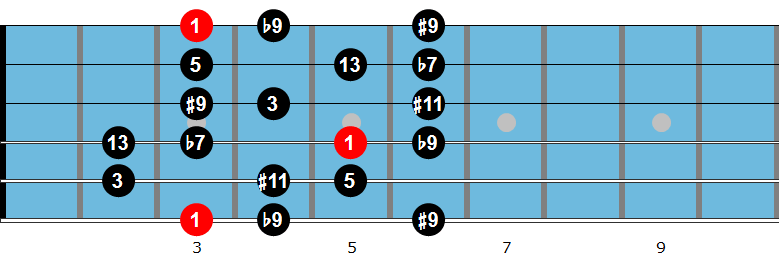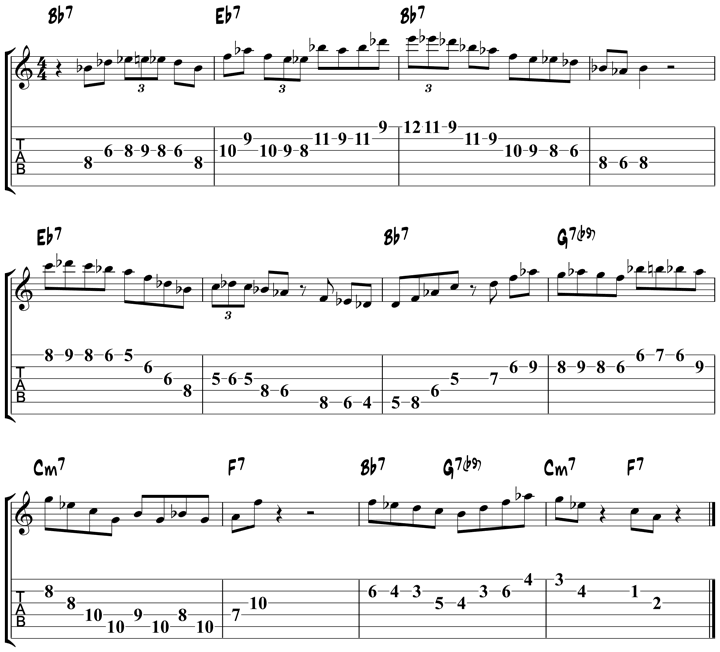The dominant diminished scale is one of the most commonly used symmetrical scales in jazz, and will add a new level of sophistication to your dominant 7th soloing lines and phrases. In this jazz guitar lesson, you will learn how to build a dominant diminished scale, how to play four fingerings for this scale on the fretboard, as well as study common licks and a sample jazz blues solo that uses this scale in their construction.
The dominant diminished scale is used to solo over dominant 7th chords, or more specifically 7b9 chords.
The dominant diminished scale can be applied to the V7 chord in a 2-5-1 chord progression, as well as the VI7b9 chord in any tune you are improvising on, which you will often see in a rhythm changes and jazz blues progression.
What Is a Dominant Diminished Scale?
Before we take this scale to the fretboard, let’s take a look at how to build the dominant diminished scale, as well as how it compares from an interval standpoint to other 7alt scales, such as the Phrygian dominant and altered scales.
The dominant diminished scale is a symmetrical scale: there is a symmetry to the interval construction of the scale (alternating half steps and whole steps). Because of its interval construction, this scale is also referred to as the half-whole diminished scale.
Here is how the dominant diminished scale looks from both an interval standpoint, as well as the intervals between each note in the scale so that you can visualize the half step (H) – whole step (W) interval construction of this symmetrical scale.
| Dominant Diminished | 1 | b9 | #9 | 3 | #11 | 5 | 13 | b7 | 1 |
|---|---|---|---|---|---|---|---|---|---|
| H | W | H | W | H | W | H | W |
As was mentioned earlier, you can use the dominant diminished scale to solo over 7th chords, especially when you want to create a sense of tension over that chord. When doing so, you will be highlighting the tension notes b9, #9, and #11 in your lines.
To compare this scale to other 7alt scale choices, here is a chart that lays out the dominant diminished scale, altered scale, and Phrygian dominant scale, so you can easily compare the intervals between these three scales.
Notice that the dominant diminished scale is the only one of the three that has a natural 13th interval, which ends up becoming the characteristic note of this scale when compared to the other 7alt choices below.
| G Dominant Diminished | G | Ab | Bb | B | C# | D | E | F |
|---|---|---|---|---|---|---|---|---|
| 1 | b9 | #9 | 3 | #11 | 5 | 13 | b7 | |
| G Altered Dominant | G | Ab | Bb | B | C# | Eb | F | |
| 1 | b9 | #9 | 3 | #11 | b13 | b7 | ||
| G Phrygian Dominant | G | Ab | B | C | D | Eb | F | |
| 1 | b9 | 3 | 11 | 5 | b13 | b7 |
As you can see, the dominant diminished scale is similar to other 7alt scale choices, but the natural 13th interval allows it to sound distinct from other scales when applied to your soloing lines and phrases.
Dominant Diminished Scale Fingerings
Now that you know how to build the dominant diminished scale, and how to apply it to your soloing phrases, you can learn four common fingerings for this scale as you take this theoretical knowledge to the fretboard.
Each fingering is written out from a G root note, so make sure to take these scale shapes to all 12 keys in your practicing in order to get a full understanding of how the dominant diminished scale sits on the fretboard.
Dominant Diminished – Root On String 6
This first fingering has the root note on the 6th string, and runs up two octaves in position from that starting note:
Listen & Play Along

Dominant Diminished – Root On String 5
The next dominant diminished scale fingering features the root note on the 5th string, working up two octaves in position from that starting note. Once you have these first two shapes under your fingers, try putting on a G7b9 backing track and soloing over that chord using these two Dom Dim Scale shapes to create your lines.
Listen & Play Along

Dominant Diminished – Shifting Shape On String 6
You will now move on to a very common shifting shape for dominant diminished, starting with the root note on the 6th string. When this scale is under your fingers, try playing up and down the in-position 6th-string shape, followed by this shifting 6th-string shape, in order to compare those two scale shapes on the fretboard.
Listen & Play Along

Dominant Diminished – Shifting Shape On String 5
The last scale shape you will learn in this lesson is a shifting dominant diminished scale with the root note on the 5th string. Again, once this shape is under your fingers, put on a G7b9 backing track and solo using both the 6th and 5th-string shifting shapes as you take these scales to the improvising side of your practice routine.
Listen & Play Along

Dominant Diminished Scale Pattern
To help dig deeper into this important scale, this lesson will cover one of the most commonly used dominant diminished scale patterns in jazz.
Learning to play this four-note pattern, and apply it to your minor key and jazz blues soloing ideas, will allow you to continue your exploration and application of this jazzy sounding scale in your jazz guitar studies.
To begin, here is the pattern applied to a D Dominant Diminished Scale.
Notice that the pattern is four notes long (Eb-D-Eb-F to begin), then it is repeated starting on F#, then A and so on as you run up this two-octave scale shape.

Begin by memorizing this pattern along with a metronome, in this key and then in others as you work on it further in the woodshed.
Once you have this pattern comfortably under your fingers, you’re ready to apply it to both minor key ii V Is as well as a jazz blues chord progression.
Dominant Diminished Minor ii V I
The first place that you can try applying this pattern is over a minor key ii V I chord progression, to outline the V7alt chord in bar two of this phrase.
Here is a sample lick to get you started with this application. After learning the lick in a number of keys, try soloing over minor ii V Is or tunes with minor ii V Is, and apply the dominant diminished scale and pattern as you solo over each V7alt chord in the progression.

Dominant Diminished Blues Lick
You can also apply this dominant diminished scale pattern when soloing over a jazz blues chord progression.
Since there is a VI7b9 chord in bar 8 of a jazz blues (D7b9 in the key of F), you can use the D7b9 dominant diminished scale to outline this chord in your jazz guitar solos.
Here is a sample lick that you can learn to help get you started. Try learning the lick as is, then take it to other common keys as you continue to explore this idea further in the practice room.

As you can see, it is only one pattern, but one that you can apply to several musical situations.
Dominant Diminished Scale Licks
To help you take these scale fingerings from the technical side of your practice routine to the improvisational side, here are 2 common dominant diminished scale licks that you can work in 12 keys and add to your jazz guitar solos.
The first lick uses a G dominant diminished scale to outline the V7 chord in a short, 2-bar ii-V-I chord progression in the key of C major.
Listen & Play Along

The next lick in this lesson uses the dominant diminished scale to outline the G7 chord, V7, in a long ii-V-I in the key of C major.
Listen & Play Along

After you have worked these three licks around the fretboard and practiced applying them to improvisational settings, try writing three to five licks of your own that use the dominant diminished scale.
Dominant Diminished Scale Sample Solo
The final item in this lesson is a sample jazz blues solo that uses the G dominant diminished scale to solo over the VI7b9 chord in bars 8 and 11 of the tune.
After learning this sample solo, try improvising over a jazz blues progression and use the dominant diminished scale to outline the VI7b9 chord when it comes around in bars 8 and 11 as you take this scale to the next level.
Listen & Play Along

More Guitar Scale Lessons



I’m wondering if you might want to include the more “position friendly” fingering that looks like:
————————————————————3–4–6—-
————————————————3–5–6—————-
————————————-3–4–6—————————
————————–3–5–6————————————–
————-4—5—7————————————————-
–4–6–7————————————————————–
Great Site Matt, I have learned so much reading and employing your vast information, thank you for all you have done us guitarist out here struggling to get better. Has it been mentioned, that in the above Dominant Diminished scale, on the 6th string, there is a b9 (G#/Ab) missing on the 4th string (6th fret/4th string).
Thanks for the feedback, Aranos! I fixed the b9.
Is there a good rule of thumb as to when it is more preferable to use this symmetrical diminished scale rather than the altered dominant scale? The perfect 5th in the diminished scale is the only difference between the two AFAIK.
A lot of the time if the chord is just a b9, or a 13b9, the I’ll use this scale. If it’s a 7alt or part of a ii V i in a minor key then I tend to use the altered scale more. Not really a strict rule, but more of a guideline to start with.
You’ve got an example above of the dominant-diminished scale used over a minor ii V, though. Is that to say that whenever a 7b9 or 7#9 chord is used, it’s likely best to assume #11 and natural 13 from this scale?
Hey. Yes there are options and then we can make choices. This is an option over any 7th or related chord, but then we have our preferences. Try it out, if you dig it go for it, if not use this over other types of 7th chords. And yes, this scale produces a #11, 13 sound.